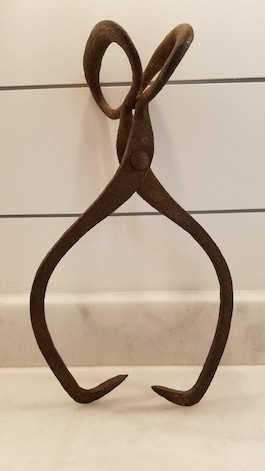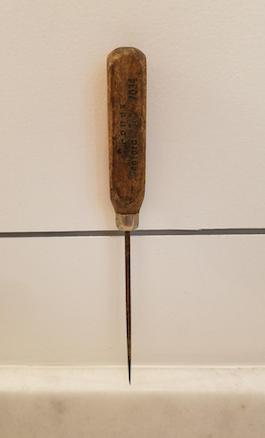ICE … It’s Cool and We Need It!
My grandfather drove an ice truck back in the day. In fact, I still have the tongs he used to muscle around massive 300-pound blocks of the frozen stuff. In his day, ice was made using a salt-brine process inside an “ice plant.”
The ice-making room was a vast expanse that contained a huge in-floor tank of the briny liquid in which large metal cans containing fresh water were submerged. Each tank was fitted with a wooden lid with a small opening where a pencil-size rubber air tube was inserted.
As the water began to cool, air was blown into the water-filled can. Doing so kept the water in motion, a process that allowed most of the air bubbles to rise and escape. This is what made sparkling, clear ice. Ice containing air bubbles is cloudy and unappealing. And, of course, not solid through and through.
Each metal can was fashioned with inverted creases that, when the ice block was completely frozen, those indentions formed the “score lines” that divided the ice into specific sizes. After approximately three days, the ice was ready to “pull.”
Using overhead hoists, workers attached chains to the metal cans and “pulled” them one by one from the brine tank. Then they’d dump the frozen block from the can and using their tongs, manhandled the four-feet by two-feet by one-foot hunks of frozen water into a freezer for storage until delivery time.
Many ice plant workers had their favorite tongs and kept them as their own, much like medical examiners, carpenters, electricians, and writers have their favorite work implements.

My grandfather’s ice tongs
The ice man, the person who carried ice to neighborhood homes, loaded enough 300-pound blocks to satisfy the needs of his customers. Typically, in those days, homeowners placed a card in the window indicating how many pounds of ice they wanted to get them through until the next delivery day. The iceman would then use an ice pick to chop off the desired amount (remember the 25, 50, 75, or 100-pound blocks I mentioned above).
Once the ice man whacked off a chunk of the correct size, using tongs to grasp the cold and slippery block, he’d carry the ice to the house where he’d place it inside the icebox. Most homes in those days, especially the homes of the middle to lower income families, did not have electric refrigerators. Instead, food was kept cool inside an icebox.
The ice man was a favorite of neighborhood children who’d often beg him for a sliver or small chunk of ice. This, in that day, was a treat on hot summer days.
Today, ice is made differently, of course, and wooden iceboxes are a thing of the past, as are the mule-pulled ice wagon and/or ice trucks. However, we still depend heavily on ice to cool our drinks on summer days. It’s a must for ice skaters and dancers. Polar bears and penguins adore it. Skiers enjoy the frozen wet stuff, and plenty of people in New England earn a nice living pushing it from roadways and sidewalks.
So, for the life of me, I just can’t understand why so many people want to get rid of it. Hardly a day goes by, if ever, without seeing a headline somewhere about some politician who wants to abolish ice.
I just don’t get it, because I like my drinks cold and I like the way those little hunks of frozen water bring back fond memories of spending time with my grandfather in the ice house.
We. Need. Ice.

My grandfather’s ice pick. Printed on its sides are the company name and a telephone number to call for 24-hour emergency ice service






My family didn’t qualify as lower-middle class. We had to store ours in a galvanized laundry tub. It’s amazing how long it lasted, wrapped in a surplus wool army blanket. We’d keep milk and other perishables in the tub, outside the wrapped ice. When we needed ice for drinks, we’d unwrap a corner and chip some off with our handy old ice pick.
Before air conditioning in movie houses my hamster would bring in a bog block of ice and a giant fan and advertise the first air- conditioned theater. My dad, a surgeon who has passed, left his (cleaned) personal tools to all the grandchildren
In Germany in the late 70s the “refrigerator” in our 300 year old house we were renting was an ice box. We went out and bought an American refrigerator at the PX. Had to have a step down transformer to run it due to the voltage differences. There used to be a restaurant in Athens, TX called “The Ice House” because it was converted from an old ice house.
My grandfather used to deliver janitor supplies. I remember going along on his day route. We stopped one place where they made pickles. It was something I had never seen and I don’t know that other kids my age would have gotten to see something like that. I do remember in Blue Birds and Brownies touring bakeries and even a cotton gin and then the sewing factory where my grandmother worked.
Thank you for sharing your family history of the ice house and the ice man. Then there was the milkman too.
Excellent description of icemaking, Lee. I remember those days when the iceman carried huge blocks of ice up to our third floor apartment. It’s another memory our kids and grandkids will never experience.